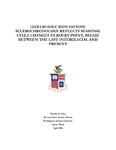| dc.rights.license | In Copyright | en_US |
| dc.creator | Yates, Hayden R. | |
| dc.date.accessioned | 2016-07-22T19:52:24Z | |
| dc.date.available | 2016-07-22T19:52:24Z | |
| dc.date.created | 2016 | |
| dc.identifier | WLURG38_Yates_GEOL_2016 | |
| dc.identifier.uri | http://hdl.handle.net/11021/33398 | |
| dc.description | Hayden R. Yates is a member of the Class of 2016 of Washington and Lee University. | en_US |
| dc.description | Thesis; [FULL-TEXT FREELY AVAILABLE ONLINE] | en_US |
| dc.description.abstract | The last Pleistocene interglacial period is thought to be characterized by warmer temperatures, higher precipitation, higher sea level and lower ice volume than today due to different orbital forcing parameters at that time. During the last interglacial, elliptical eccentricity, pronounced obliquity, and minimal precession perpetuated changes in solar insolation distribution in the Northern Hemisphere, specifically by creating a stronger summer insolation and a weakened winter insolation. In this study, δ18O and δ13C isotopic records were used to investigate the impacts of solar variability on tropical Caribbean seasonality at the last interglacial. Growth rate and stable isotope data were obtained from two Pleistocene corals (BZRP12 and BZRP14) from Rocky Point, Belize and two modern corals from Rocky Point, Belize (BZ14RP) and Coral Gardens, Belize (CG14) to reconstruct seasonal cyclicity in coral geochemistry. Corals were sampled at 4, 6, 8, 10 samples per coral year for δ18O and δ13C to determine the best sampling resolution to represent maximum seasonality, which yielded an optimal resolution of 10 samples per year. From 4 to 10 samples per year, the Pleistocene coral BZRP12 expressed a larger δ18O range by 1.81‰ and a larger δ13C range by 1.56‰. For annually resolved data, δ18O ranged 0.94‰ in the modern coral and 1.32‰ and 2.13‰ in the Pleistocene corals. δ13C ranged 1.14‰ in the modern coral and 1.72‰ and 1.96‰ in the Pleistocene corals. We interpret the higher range in Pleistocene δ18O and δ13C to reflect a higher latitudinal range of the Intertropical Convergence Zone at that time. The δ18O of our corals likely reflects precipitation and/or temperature, whereas δ13C may reflect seasonal change in the flux of terrestrial ‘light' carbon to the reef. Maximum seasonal paleotemperature change (if δ18O reflects only temperature and no ‘salinity' effect) calculated from δ18O data suggest that the maximum seasonal range in temperature of the modern coral was the lowest (4.7°C), BZRP14 geochemistry represented a larger seasonal range (6.6°C), and BZRP12 expressed the largest seasonal range (10.7°C). These results support that increased summer insolation and decreased winter insolation acting on the Northern Hemisphere enhanced seasonality during the last interglacial. | en_US |
| dc.format.extent | 37 pages | en_US |
| dc.language.iso | en_US | en_US |
| dc.rights | This material is made available for use in research, teaching, and private study, pursuant to U.S. Copyright law. The user assumes full responsibility for any use of the materials, including but not limited to, infringement of copyright and publication rights of reproduced materials. Any materials used should be fully credited with the source. | en_US |
| dc.rights.uri | http://rightsstatements.org/vocab/InC/1.0/ | en_US |
| dc.subject.other | Washington and Lee University -- Senior Thesis in Geology | en_US |
| dc.title | High Resolution Isotope Sclerochronology Reflects Seasonal Cycle Changes at Rocky Point, Belize Between the Last Interglacial and Present | en_US |
| dc.type | Text | en_US |
| dcterms.isPartOf | RG38 - Student Papers | |
| dc.rights.holder | Yates, Hayden R. | |
| dc.subject.fast | Corals | en_US |
| dc.subject.fast | Temperature -- Seasonal variations | en_US |
| dc.subject.fast | Belize | en_US |
| dc.subject.fast | Pleistocene Geologic Epoch | en_US |
| local.department | Geology | en_US |
